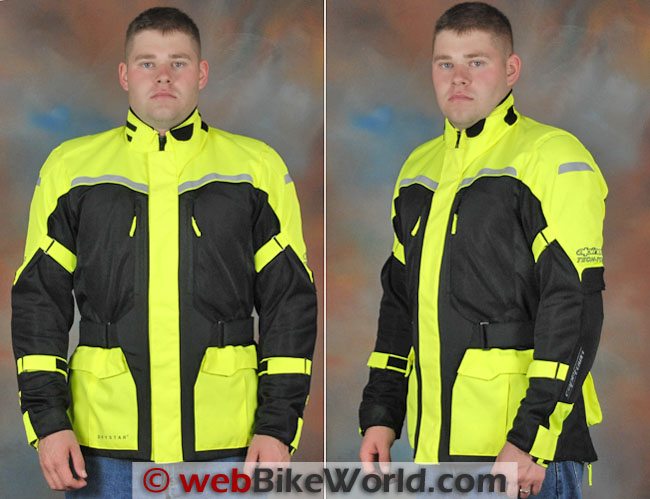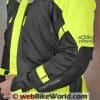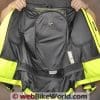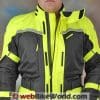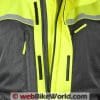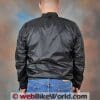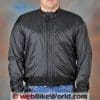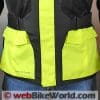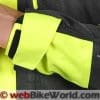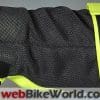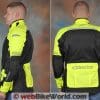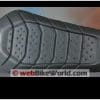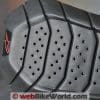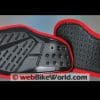The Alpinestars Cape Town Air Drystar jacket is both unique and unusual. It’s a 3/4-length jacket but the outer shell is mostly mesh. A Drystar waterproof membrane removable liner is included. The Cape Town Air is very comfortable, with a correct shape and enough adjustments to custom fit anyone.
It also flows a lot of air and it’s wearable even in 90+ F temperatures, while providing 3/4-length jacket protection and storage. The Drystar liner is easily removed or inserted, making the Cape Town Air an excellent three-season motorcycle riding jacket.
Although the third quarter of a calendar year is a good time for the manufacturers to introduce new products to their dealer network for the next season, many motorcyclists in a northern hemisphere Fall season are usually thinking more about parking their bikes for winter.
So when the Alpinestars Cape Town Air Drystar jacket was introduced in the latter part of 2011, it may have been overlooked by many potential customers. And by time the company’s Spring 2012 lineup was introduced, the Cape Town was forgotten. That’s too bad…but it’s not too late. There’s still plenty of summer left and the Cape Town jacket will also bring you well into this year’s cooler weather that’s (hopefully) on the way.
And for those living in the more temperate climes, where winter temperatures can go from cool to warm-ish in a single day, it may well be perfect. A 3/4-length mesh jacket is both unique and unusual, but it works really well and surely more than one Alpinestars competitor has experienced a forehead-slapping “Why didn’t we think of that?” moment. Let’s take a look…
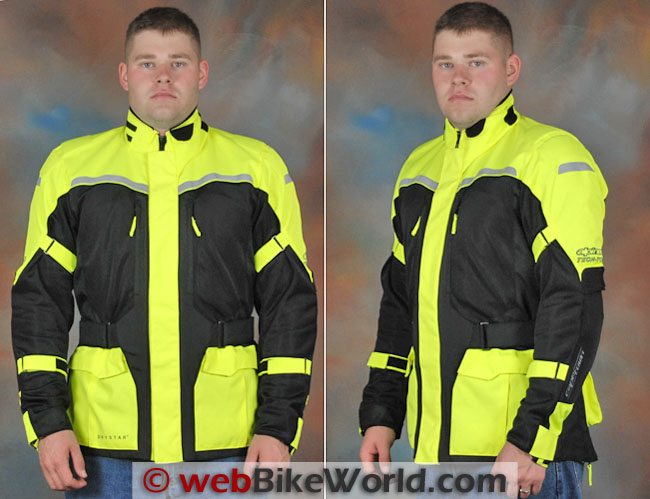
The Alpinestars Cape Town Air Jacket
The idea of a 3/4-length jacket for hot-weather riding seems, well, unusual, to say the least.
Actually, it didn’t make sense at all to me at first — but it didn’t take long before the light bulb went off in my head. What was that short-lived beer commercial?
rilliant!, the Guinness guy says…
Now, after riding with the jacket in Mid-Atlantic August temperatures ranging from the high 80’s to low 90’s (30 to 34 C) and with high humidity, it makes sense.
I just assumed that riding in the hottest weather summer dishes out would mean a lightweight, short jacket with worrying levels of protection, but it’s not necessarily so.
The Cape Town Air jacket not only flows a lot of air — more, in fact, than some short summer jackets I’ve tried.
It also gives you the sense that there’s a better level of protection between you and that steaming pavement when and if it becomes necessary.
I must say that wearing a 3/4-length jacket in 92 degree temperatures seems, well, a bit strange at first. And I’ve noticed more than one double-take from a passing T-shirt-wearing fellow rider.
But as long as you’re moving, the air is flowing.
Get stuck in traffic and, well, the effect is pretty much the same as you’d get no matter what type of gear you’re wearing.
The mesh fabric covers most of the front and rear of the jacket though, and as soon as even a modicum of air flows through, it can be felt as the moisture evaporates from your undies.
All of the black-colored sections you see in the photos are mesh, other than the elbow and forearm in the rear, which are covered by a thicker black ballistic nylon for abrasion resistance.
The mesh fabric has a tight weave and it seems relatively dense, but it flows as much air as just about any other jacket of this type I can think of.
All of the fabric used throughout the Cape Town jacket feels softer than that what is found in many mesh jackets. It’s pliable and comfortable — important for a hot-weather riding jacket.
Alpinestars also paid special attention to the lining, collar and other areas that will contact the rider, who most likely would be wearing a T-shirt underneath.
Fit, Adjustment, Construction and Styling
The jacket also has a wide range of adjustment possibilities, with two adjusters on the arm, located at the forearm and the biceps. An oversized (48 mm, or 2″) waist belt adjuster is located on either side, working through big square plastic “D” rings.
These help to give the Cape Town that “bespoke” fit and, I have to say, it’s instantly comfortable and the size large is a perfect fit for me, which makes a big difference in hot-weather riding.
The Alpinestars size chart is very specific; a size large jacket is listed as 42-1/8″ to 43-3/4″ chest size. This, I think, is exactly correct, although surely one-eight of an inch (0.125 or 3 mm) won’t be a deal-killer?
In any case, the size L is a perfect fit for my 43″ chest — I didn’t have to move any of the adjusters at all. And the best part is, the jacket fits perfectly with the liner removed, unlike many other 3/4-length jackets that balloon up a size or two when the guts are stripped.
This is important, as it helps keep the padding in place while preventing the jacket from blowing around in the wind. And, it looks better, fitter and trimmer too.
Liner Fit
The Drystar liner supplied with the size large jacket has a slightly snug fit; I’d say it’s more like a size 42″-43″ chest.
This actually is a good idea though, because the snug fit helps to keep the cool air out when it’s raining and it allows the jacket to have a trimmer fit so that it doesn’t gain too much bulk when the liner is removed (which it will be for most summer riding).
Construction and Stitching
The stitching is single row at many of the attachment points, a bit of a disappointment but probably what keeps the price reasonable.
It would have been nice to see double stitching or bar tacking used in locations such as the attachment points for the waist belt.
Most of the joined fabric sections on the jacket are attached with single-row stitching, but the ballistic nylon sections on the back of the arms are doubled.
I have no reason to believe the construction isn’t adequate, and the upside is that the stitching appears to be of excellent quality, the rows are perfectly aligned and there wasn’t a loose thread to be found on this example. But still…
Styling
The styling doesn’t break any new ground, but the Cape Town looks up-to-date in the modern Adventure Touring idiom.
The high-visibility yellow also helps to reflect the sun’s rays, although the jacket is also available in a black/dark gray combination.
Too bad they didn’t offer other colors, like red, blue or green. Maybe they will once it’s determined how well the Cape Town sells.
Labeling includes the stylized “A*” sewn on to the collar in the front and again in the rear.
Also, the “Alpinestars” word text logo sewn on to the outsides of both upper arms with the text (all caps) “Tech-Touring” below.
The word “Drystar” is printed in uppercase at the front lower right hem and the “Alpinestars” text word as an outline reflective heat-sealed tape pressed on to the flap of the storage pocket in the rear.
I could probably do without the text on the arms and I’d rather the Alpinestars reflective logo on the back (it would be better as a solid stripe of reflective tape).
But, I suppose it’s better than some jackets, which act as a walking, riding billboard.
I suspect, however, that the primary audience for this jacket is the more experienced rider, probably a BMW GS or KTM 990 Adventure owner, to whom subtlety is more appropriate.
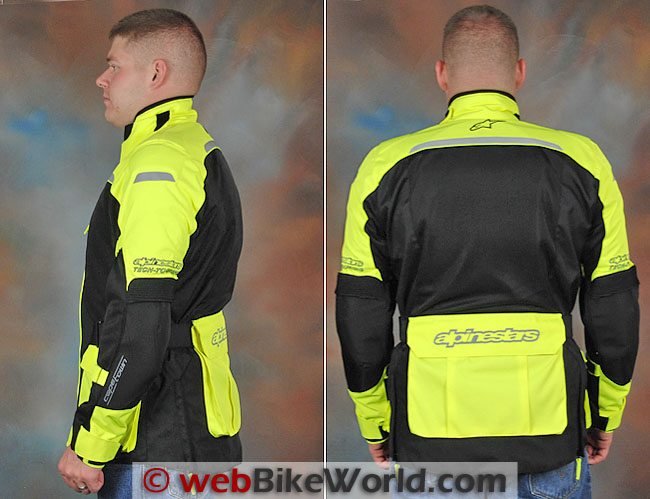
Removable Drystar Waterproof Liner
The jacket comes with a “Drystar” removable liner; Drystar is the name used by Alpinestars to indicate their waterproof liners and jackets.
The liner used in the Cape Town Air Drystar jacket has been massaged for next-to-the-skin comfort.
It has a very comfy and soft micro-fleece lining, with a separate type of soft, perforated lining inside the arms to keep the shell away from the skin and provide a bit of air circulation.
The Drystar liner is definitely waterproof, at least in our experience, which included rides in a couple of torrential summer downpours just for the purpose of evaluating the liner.
The outer shell gets wet, of course, and the water blows through the mesh as you’d expect, but the Drystar liner does an amazing job.
This makes the Cape Town jacket a good choice for three-season riding.
And you don’t even have to bother about attaching the liner to the inside — just pull it out of the rear storage pocket, slip it on and throw the Cape Town on over the top. It’s as simple as it gets.
If you really want to, or if you need to semi-permanently block the air coming in through the mesh for cool-weather use, you can attach the liner at the cuffs (two snap straps) and the collar, along with the tiny zippers along each side of the plackets in front.
The liner has been kept simple — and simpler is better in this case.
Elastic at the sleeve cuffs and waist add to the comfortable and flexible fit, whilst keeping the cool and/or wet air from spoiling the party. Also, the absence of external pockets ensures full waterproof integrity.
The only pocket in the liner is what Alpinestars calls a “Napoleon” pocket, located inside the left placket.
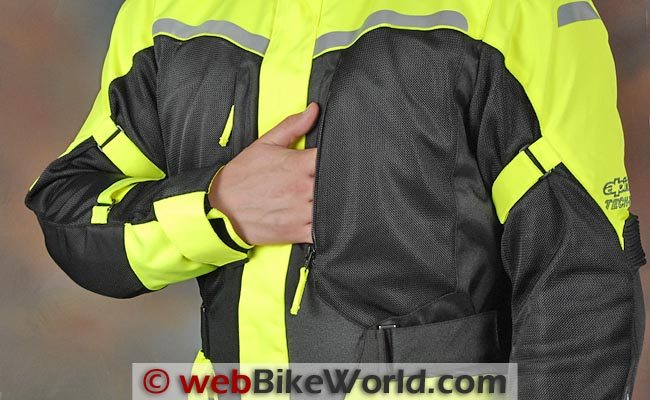
Alpinestars Cape Town Jacket Details: Mesh Hybrid Jacket Shell
In addition to the large mesh sections in the front and rear of the Cape Town jacket, the yellow sections seen on the example in the photos are made from the typical polyester “Cordura-like” fabric found in many motorcycle jackets.
It’s what I would call a mid-weight variety; it’s not as thick as winter-weight Cordura used in the Rev’it Cayenne Pro (review), for example, but not as thin as the fabric used in the Dainese Aspide jacket (review).
The “ballistic nylon” used in the back of the arms is double-stitched and seems fairly hefty, similar to the ballistic nylon found on your typical 3/4-length jacket.
Alpinestars doesn’t list specifications for the fabric types, so I’m guessing.
A narrow strip of solid polyester is placed vertically on either side under the arms, to join the front and rear mesh sections.
The jacket has a (surprisingly) wide wind flap in back of the main zipper, doubled with another flap in front that covers the half of the zipper that includes the runners.
I say surprising because this seems like a bit of unnecessary overkill for a mesh jacket, but it’s possible the winter-like flap arrangement adds some wind protection in cooler weather.
Actually, I don’t find it all that bothersome in hot weather, because there’s so much air flowing in through the mesh.
It’s not really necessary to have full, complete 100% mesh in every area of a jacket, as long as it’s done correctly and the important geography has good air flow (i.e., chest and back).
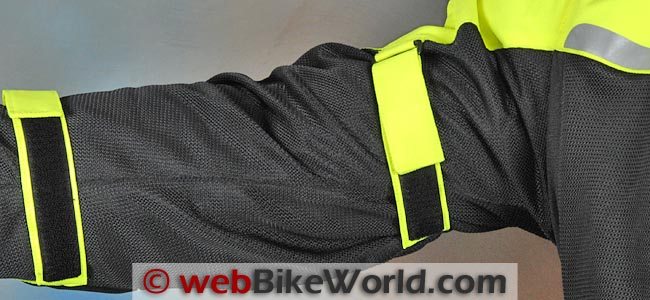
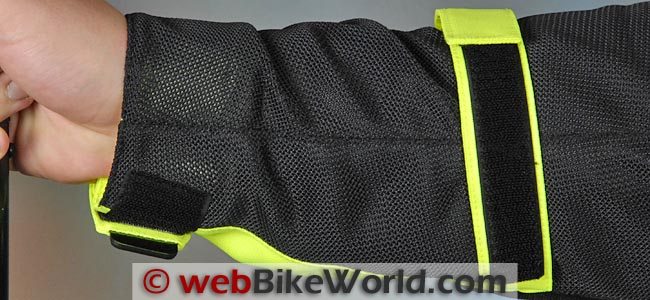
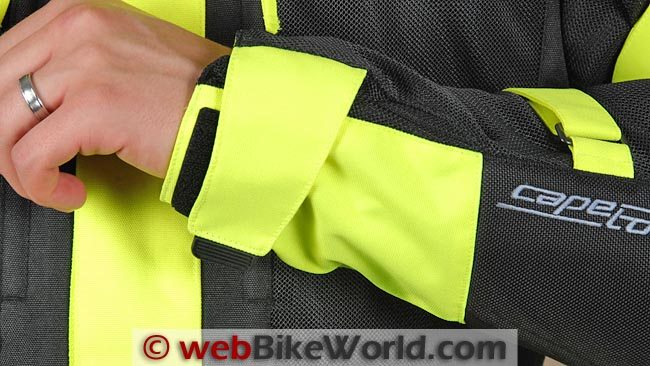
Zippers, Attachments, Collars and Cuffs
The Cape Town jacket uses YKK zippers throughout, with a medium-large-sized, nylon-tooth version in the front as the main entry zipper.
It has a double runner, so each pull can be opened independently, either from the top or bottom of the jacket.
Unfortunately, the runners are not of the locking type, which I think is an oversight, especially for the neck, since it has the ability to be left open with a metal “Sens” brand snap at the tip, which attaches to the left-hand side of the neck for extra cooling in super-hot weather.
So it would be nice if the zipper pull could be locked a few inches down from the top, although attaching the covering flap with its hook-and-loop seems to do the job.
Other than the main zipper and the two internal placket vertical zippers on each side in front to attach the liner, the only other zippers on the Cape Town jacket are found in the two front top pockets.
These are both YKK brand and are the coil type, rather than tooth. They work fine and have a “cute” yellow contrasting pull attached (as does the upper runner on the main entry zipper).
The jacket collar is wide and tall, which again seems a bit incongruous with the jacket’s hot-weather raison d’être. But, it can be attached over on the left side with a metal snap, and this creates a “V” at the top of the neck.
Air flows in, around the neck and it can be felt down the back — excellent for really hot weather.
I have tried the collar both open and closed (it attaches with a hook-and-loop system that has plenty of adjustment) in temperatures up to 92 F and I was again surprised that riding with a closed collar in those conditions is not uncomfortable.
The height of the collar and the soft lining, combined with the pliable outside shell fabric, does the trick.
The sleeve cuffs are equally comfortable, also because they seem wider than average and have more adjustment.
The design is simple, with a “V” shaped dart made of the black mesh fabric allowing the cuffs to taper down to a precise fit.
The wide attachment strap and generous helping of hook-and-loop makes it all work and the closed cuffs fit into the gauntlets of all the summer gloves I’ve tried.
Finally, the jacket has a nearly full-length internal pants attachment zipper, which works with a variety of Alpinestars trousers.
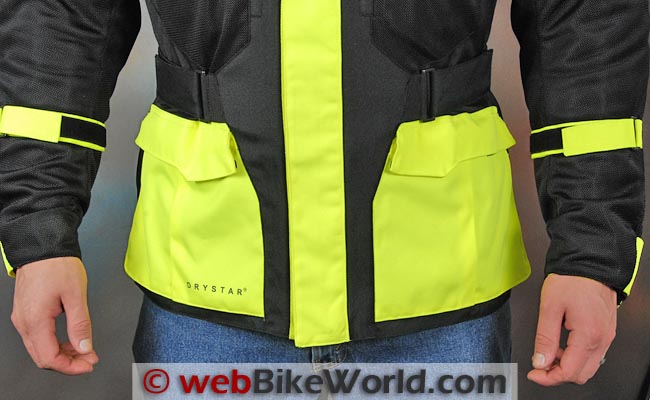
Pockets
The Cape Town jacket has nearly the full complement of expected 3/4-length jacket pockets, with two large front cargo pockets at the bottom and two chest pockets up top.
The large front chest pockets (~180 mm wide by 160 mm tall) are unlined (other than with a light taffeta-type of mesh), so they do not block the air flow. However, they are not in the least waterproof.
The lower pockets are approximately 200 mm wide by 200 mm tall and they are attached at the inside near the zipper but have an expansion pleat added towards the outside.
These pockets, along with the large rear storage pocket, are constructed from the solid polyester fabric, but are unlined.
They don’t let much air flow through, so it probably would have been nice if at least one of them was lined, as none of them are waterproof.
Thus, there is no waterproof storage in the Cape Town jacket, other than in the single placket pocket on the left-hand side internal to the Drystar removable liner.
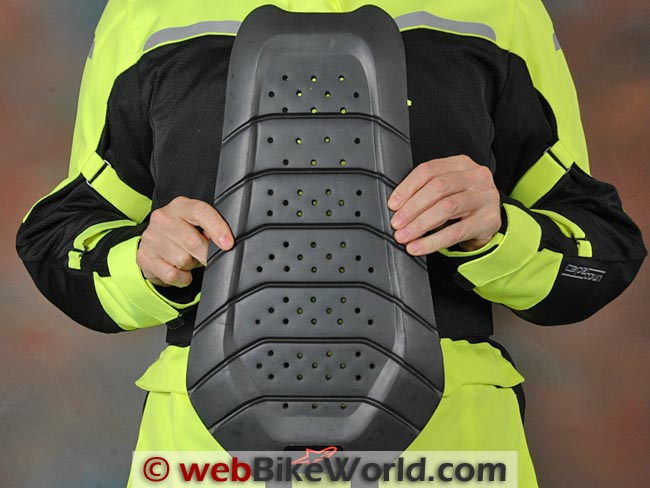
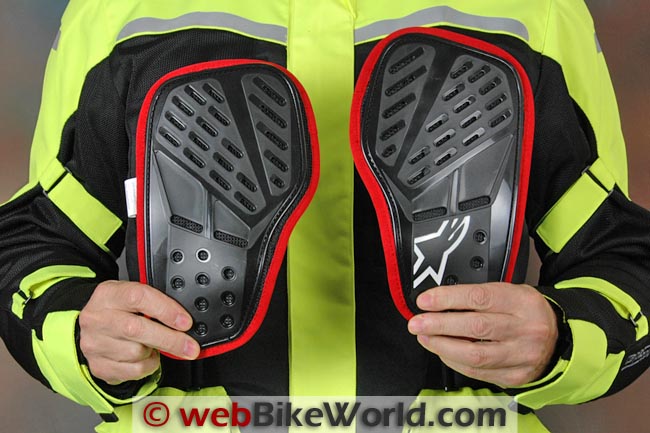
Armor and Padding
The Cape Town jacket comes with CE approved (claimed) “Bio Armor” shoulder and elbow protectors. These feel like perhaps Level 1 pads, as they do not have hard backs. But, they do add to the flexibility and comfort of the jacket.
Yet another interesting feature of the Cape Town jacket is that it comes with a padded back protector and two smaller chest protector pads, located in internal pockets in the upper chest, behind the vertical mesh pockets.
The front and rear padding can be easily replaced by the Alpinestars Bionic Armor back protectorand the Alpinestars Bionic Chest Pads. The back protector is a CE approved Level 1 device and it’s reasonably priced with a list of $29.95.
The optional Bionic chest protectors are not CE tested and cost $39.95 for the pair.
Both the optional back protector and chest protectors have ventilation holes molded in, and they actually feel like they flow more air than the foam padding that comes with the jacket, so this is definitely a worthwhile upgrade (especially the back protector).
Since too few street riders wear auxiliary back protectors, when one can be fitted to a jacket so it’s unobtrusive and always there when it’s needed, it’s a good idea to seize the opportunity.
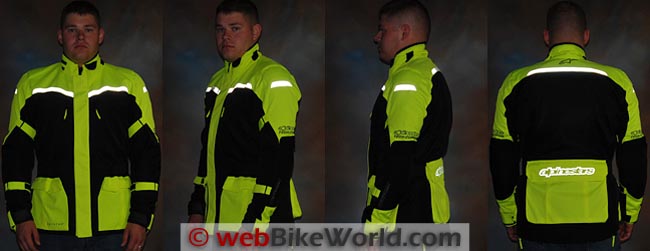


Reflectivity and Visibility
The Cape Town jacket is available in a black/gray or black/yellow combination.
The black/yellow version is preferred for summer use and the yellow also conforms to the EN471 standard for High Visibility Garments (Wikipedia).
It’s a nice, cheery sort of yellow that doesn’t seem tinged by that sickly lime green shade, although if it meets the EN471 standard, it’s probably no different than any other that does the same.
The jacket also has several sections of reflective tape heat-sealed on the shell, which provide good night time visibility (photo above).
| The wBW Opinionator: Alpinestars Cape Town Jacket | |
|---|---|
| Picks… | …and Pans. |
|
|
Conclusion
The Alpinestars Cape Town jacket was a surprise in several dimensions for all of the evaluators who helped with this review.
It’s sort of hidden in the Alpinestars lineup, but it has a unique combination of features that, once experienced, make sense.
There may be other 3/4-length mesh jackets available, but we’re not aware of them.
The Cape Town provides good air flow in hot weather while also providing an upgraded level of potential protection — missing from many short, lightweight jackets designed for summer riding.
Something about the overall design, styling and fabric choices make the Cape Town easy to wear and very comfortable, and that goes a long way towards adding comfort to those hot-weather rides.
The high-visibility yellow reflects the sun and helps make the rider more visible in traffic — both good things, no doubt.
Not all is perfect: the front zipper should have a locking runner; the flap behind the zipper seems too wide for the jacket’s mission; and the mostly single-stitched construction leaves a few question marks.
But excellent fit, lots of adjustability, spot-on sizing and attention to details like the soft collar and jacket linings add plus points to the mix.
Top it off with a reasonable price and the availability of optional chest and back protection, and we have ourselves a winner.
| wBW Product Review: Alpinestars Cape Town Jacket | |
|---|---|
| Manufacturer: Alpinestars | List Price: $299.95 |
| Colors: Black/Gray. Black/Yellow (EN471) | Made In: Vietnam |
| Sizes: S-4XL. | |
| Review Date: August 2012 | |
Owner Comments and Feedback
See details on submitting comments.
From “T.G.” (September 2012): “Very good write up of this Alpinestars jacket. If I did not own a Motoport mesh I would have jumped on this one.
It brings to mind the what I think is the first one of these the Firstgear Kilimanjaro Air jacket from around 2005.
I wore one for 5 years from 20F to 105F and was always comfortable with just the jacket and perhaps a sweater underneath.
Motoport makes the UltraII 3/4 in mesh but it looks like a cheap dress that costs over 800 bucks with all the bells and Kevlar whistles. I sent mine back for a smaller height jacket that has to be attached to pants for the same safety.
3/4 is much safer in ever way over a shorter one. The color is very visible and Alpinestars is to be commended for jumping on the high-viz wagon. I’m beginning to see even Harley Riders (usually older) in bight green or orange HD brand jackets.
The all black sons of anarchy look is giving way to bright neons.
Perhaps it’s the effect of the Olympic running shoes and even school clothes for 2013 have bright neon as a high fashion statement.
Mesh make a great layer but usually it’s better in warm weather to just slip on a rain jacket than stop and zip in a liner especially with pants as cops will give you the evil eye standing on the side of the road in your skivvies.”
From “S.L.” (August 2012): “The concept of a 3/4 mesh jacket is not unique, nor is it particularly unusual.
The Tourmaster Sonora jacket and the Scorpion XDR Master jacket are both examples of 3/4 mesh jackets that have been around a while, and there are others.
That said, the Alpinestars Cape Town looks like a great addition to the selection available. Wearing a 3/4 jacket in the summer is no more peculiar a concept than wearing a jacket of any length in the summer is.
If you want protection, you wear a jacket. I personally think 3/4 jackets look better and are more useful, and I don’t even ride an adventure bike!”
Editor’s Note: The 3/4 length mesh jacket format is a bit unusual; there just aren’t many available compared to other types. Also, the Scorpion XDR Master jacket is no longer in production.
From “A.H.” (August 2012): “Thanks for yet another informative and well-written review. I considered purchasing a Cape Town Air Drystar jacket earlier this summer but ultimately purchased a Held Amarillo Jacket and matching Pezzo pants.
The promise of this Held combination is the same as the Cape Town Air’s — a 3/4-length jacket and pants combo that utilizes ventilating material for the hot summers and includes a fully-waterproof liner for the rain or colder months.
Although the Amarillo construction is not technically mesh, it’s “mesh-like” because it uses perforated Cordura as the primary material throughout. It does indeed allow a lot of air exchange — until you put a back-protector into it.
The back of the jacket, although completely perforated, ventilates from the inside through the back-protector pocket only.
Therefore, if you place a back-protector inside, it blocks all rear ventilation, effectively preventing any air transfer from the front of the jacket through the rear of the jacket. Whoever designed this jacket apparently does not use a back-protector in the summer heat.
If you forgo the back-protector (or if you wear a separate protector strapped to your torso), the jacket ventilates very well.
Interestingly, if you do use a back-protector in the Amarillo jacket’s back-protector pocket, an integrated cummerbund inside the jacket (which is removable) keeps the back-protector pulled tightly against your back.
So in the event of a crash, the back-protector is more likely to remain in place instead of shifting off your spine if the main jacket is too loose.
The included Gore-Tex Paclite liner is unique in that it can be attached inside the jacket or worn outside of the jacket.
On two trips to West Virginia this summer, I faced scattered thundershowers every day, and it was easy enough to pull over whenever I hit rain, grab the liner out of my hard case, and don it quickly over the main jacket and pants.
I faced multiple downpours as well as two hailstorms, and the Paclite liner did not let in a drop of rain.
Like the Cape Town Air, the Amarillo and Pezzo pants rely on a lot of single-stitching without any bar-tacking at high-stress points. After my two West Virginia trips, some of the seams are already failing.”


